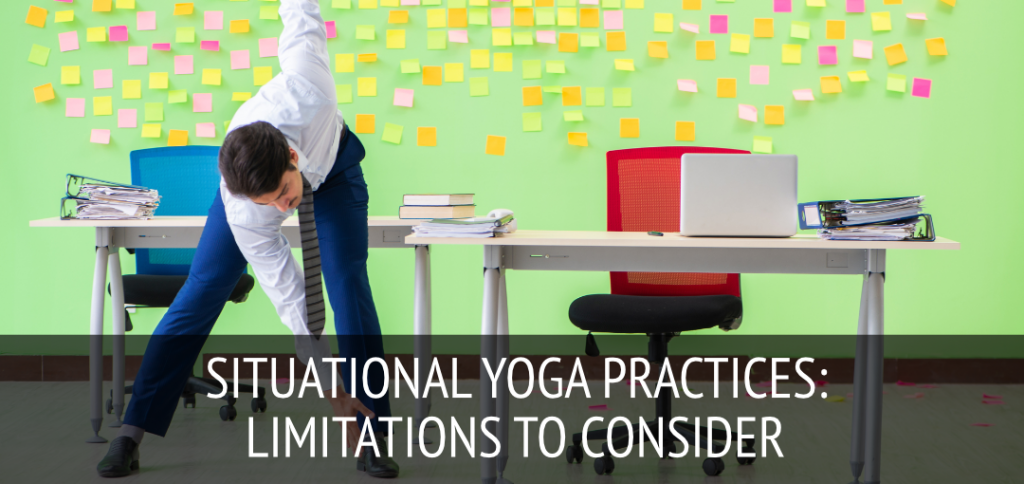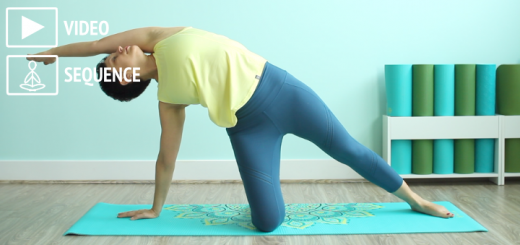You can do yoga anywhere: situational yoga practices
1My son is really into drawing; wherever we go, I always have a notebook and a pencil ready for him. When we visited Barcelona last summer, we went to all sorts of art museums to feed his love of art. He felt so inspired that he would just pull out his notebook in the middle of the exhibit hall, lean against the wall and start drawing. He can draw anywhere.
I am the same way with my yoga. I do it on playgrounds, in the grocery store line, in hotels and airports, by my desk, at the rest area, on the hiking trail – you name it. I do it whenever I feel like my body, my energy or my mind needs it. I find it empowering because I know that I can help myself feel better no matter where I am – I do not need a perfect yoga studio space for my practice (although I do enjoy it for a full-length, in-depth yoga practice).
I try to encourage the same mindset in my students, so that they had something to reach for when they are not feeling that great. Short situational practices like that are also useful when they need to prepare the body and/or mind for some activity or event (golfing, hiking, extended computer work, stressful doctor’s appointment, and anything else), or to neutralize the negative consequences of such an activity or event.
I find that doing those short situational yoga practices works on several levels:
– It helps the student feel better (physically, energetically and mentally)
– It drives home the point that yoga practice is a useful tool that can be reached for whenever and wherever to address the student’s challenge as soon as it arises
– It encourages the student to help herself and empowers her to take ownership of how she feels.
So today let’s talk about what it takes to create those short situational yoga practices for yourself and your students that could be done in weird places. There are several limitations to consider:
1. Space limitations
Where will your student be doing this practice? How big is the space and how conducive is it to movement? Is there space to get down on the floor? If not, most poses will have to be standing. Or maybe it’s an airplane seat, so all of the poses will have to be seated. Or maybe she will be doing her yoga in an MRI machine where she is not supposed to move, but she can do deep breathing and meditation. Space considerations are essential.
2. Surface limitations
What is the floor surface in the space? Is it even or uneven, hard or soft, slippery or bumpy? Will your student be wearing shoes? What kind of shoes? Our first concern is to keep the student safe, so that she doesn’t slip or trip. Or second concern is to make sure that she doesn’t exaggerate her physical imbalances if she does movement on an uneven or unstable surface (it might be advisable to stick to upper body movements in those situations.) If the student will be sitting, how comfortable will the seat be? Will there be chair arms or other people right next to her?
3. Clothing limitations
What will your student be wearing? Will it be comfortable attire, or business suite, or ski boots, or hospital gown? Each type of clothing will have its own limitations. You will need to make sure that clothing has enough give for the movements you are planning to do, and that it doesn’t expose anything. Would sweating be OK for your student in this situation? If not, you will need to take it into consideration and dial down the intensity.
4. Privacy limitations
How exposed will your student be to other people when she does her practice? Can she close the door to her office and be completely private, or will there be people all around her? How comfortable is she with other people potentially watching her, and how appropriate and considerate is it for her to be doing her practice with other people in close proximity?
Once those limitations have been considered and discussed with your student, you can use the same templates we’ve already discussed to create short yoga practices for physical tension, energy management or mental state. Next week we will feature a short yoga practice for the neck and upper back tension done entirely standing – tune in!
[jetpack_subscription_form]





















Great! I would love to practice yoga but I’m considering space and time which I currently do not have. 🙂